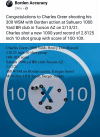codyadams
Well-Known Member
There are a lot of people around running the heaviest for caliber projectiles available, and at the same time never shoot an animal over 500-600 yards, with their average shot being sub 300 yards. These people may certainly benefit from light super fast monos, and even on the rare 500-600 yard shot, the difference in wind drift between the heavies and light monos is not a terribly big factor, usually within 1 MOAish @10mph, and generally still sufficient energy to do the job.
Now on the other hand, those that take average shots at 500 or more, and reach out to 1000 or more, will likely benefit from the heavier bullets. With a well developed load, well practiced shooter, well built rifle and a good rangefinder, the only component of the shot left at a guess is wind drift, and you will almost never find a light mono that will give more room for wind estimation error (ie less wind drift) than a heavier high bc bullet. Between me and the few people I hunted with last season, the average shot we took on 14 critters was right around 650 yards, and in Wyoming (as many other places I'm sure) the wind is always going. Our long range guns have heavy high bc bullets in the majority of them.
There are a couple exceptions with newer designs, you can almost have your cake and eat it too. I am going to be running the 250 Badlands SBDII 250 grain .338 bullet in my .338 Norma. It is pretty light for chambering, considering the common place here is the 300 Berger, so 50 grains lighter is significant. However, it is also listed at having a .410 G7, not far behind the .429 G7 of the 300 Berger, but with significantly more speed. With a lot of the new bullet selections available, there are several bullets that will satisfy both the b.c. freak, as well as the speed freak.
And I love it. Ha ha!
Now on the other hand, those that take average shots at 500 or more, and reach out to 1000 or more, will likely benefit from the heavier bullets. With a well developed load, well practiced shooter, well built rifle and a good rangefinder, the only component of the shot left at a guess is wind drift, and you will almost never find a light mono that will give more room for wind estimation error (ie less wind drift) than a heavier high bc bullet. Between me and the few people I hunted with last season, the average shot we took on 14 critters was right around 650 yards, and in Wyoming (as many other places I'm sure) the wind is always going. Our long range guns have heavy high bc bullets in the majority of them.
There are a couple exceptions with newer designs, you can almost have your cake and eat it too. I am going to be running the 250 Badlands SBDII 250 grain .338 bullet in my .338 Norma. It is pretty light for chambering, considering the common place here is the 300 Berger, so 50 grains lighter is significant. However, it is also listed at having a .410 G7, not far behind the .429 G7 of the 300 Berger, but with significantly more speed. With a lot of the new bullet selections available, there are several bullets that will satisfy both the b.c. freak, as well as the speed freak.
And I love it. Ha ha!

